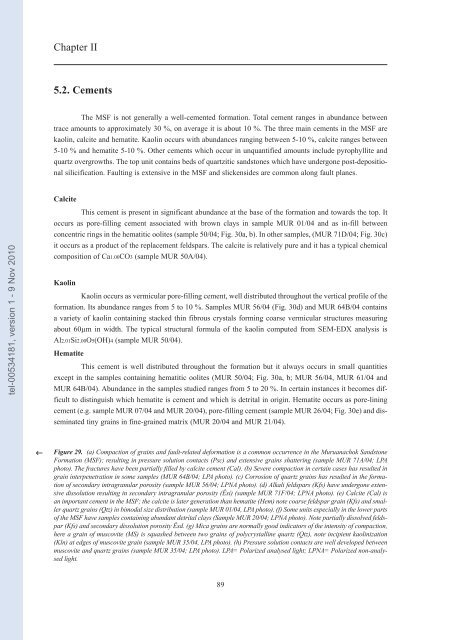Etude stratigraphique, pétrographique et diagénétique des grès d ...
Etude stratigraphique, pétrographique et diagénétique des grès d ...
Etude stratigraphique, pétrographique et diagénétique des grès d ...
You also want an ePaper? Increase the reach of your titles
YUMPU automatically turns print PDFs into web optimized ePapers that Google loves.
tel-00534181, version 1 - 9 Nov 2010<br />
�<br />
Chapter II<br />
5.2. Cements<br />
The MSF is not generally a well-cemented formation. Total cement ranges in abundance b<strong>et</strong>ween<br />
trace amounts to approximately 30 %, on average it is about 10 %. The three main cements in the MSF are<br />
kaolin, calcite and hematite. Kaolin occurs with abundances ranging b<strong>et</strong>ween 5-10 %, calcite ranges b<strong>et</strong>ween<br />
5-10 % and hematite 5-10 %. Other cements which occur in unquantified amounts include pyrophyllite and<br />
quartz overgrowths. The top unit contains beds of quartzitic sandstones which have undergone post-depositional<br />
silicification. Faulting is extensive in the MSF and slickensi<strong>des</strong> are common along fault planes.<br />
Calcite<br />
This cement is present in significant abundance at the base of the formation and towards the top. It<br />
occurs as pore-filling cement associated with brown clays in sample MUR 01/04 and as in-fill b<strong>et</strong>ween<br />
concentric rings in the hematitic oolites (sample 50/04; Fig. 30a, b). In other samples, (MUR 71D/04; Fig. 30c)<br />
it occurs as a product of the replacement feldspars. The calcite is relatively pure and it has a typical chemical<br />
composition of Ca1.00CO3 (sample MUR 50A/04).<br />
Kaolin<br />
Kaolin occurs as vermicular pore-filling cement, well distributed throughout the vertical profile of the<br />
formation. Its abundance ranges from 5 to 10 %. Samples MUR 56/04 (Fig. 30d) and MUR 64B/04 contains<br />
a vari<strong>et</strong>y of kaolin containing stacked thin fibrous crystals forming coarse vermicular structures measuring<br />
about 60µm in width. The typical structural formula of the kaolin computed from SEM-EDX analysis is<br />
Al2.01Si2.00O5(OH)4 (sample MUR 50/04).<br />
Hematite<br />
This cement is well distributed throughout the formation but it always occurs in small quantities<br />
except in the samples containing hematitic oolites (MUR 50/04; Fig. 30a, b; MUR 56/04, MUR 61/04 and<br />
MUR 64B/04). Abundance in the samples studied ranges from 5 to 20 %. In certain instances it becomes difficult<br />
to distinguish which hematite is cement and which is d<strong>et</strong>rital in origin. Hematite occurs as pore-lining<br />
cement (e.g. sample MUR 07/04 and MUR 20/04), pore-filling cement (sample MUR 26/04; Fig. 30e) and disseminated<br />
tiny grains in fine-grained matrix (MUR 20/04 and MUR 21/04).<br />
Figure 29. (a) Compaction of grains and fault-related deformation is a common occurrence in the Muruanachok Sandstone<br />
Formation (MSF); resulting in pressure solution contacts (Psc) and extensive grains shattering (sample MUR 71A/04; LPA<br />
photo). The fractures have been partially filled by calcite cement (Cal). (b) Severe compaction in certain cases has resulted in<br />
grain interpen<strong>et</strong>ration in some samples (MUR 64B/04; LPA photo). (c) Corrosion of quartz grains has resulted in the formation<br />
of secondary intragranular porosity (sample MUR 56/04; LPNA photo). (d) Alkali feldspars (Kfs) have undergone extensive<br />
dissolution resulting in secondary intragranular porosity (Êsi) (sample MUR 71F/04; LPNA photo). (e) Calcite (Cal) is<br />
an important cement in the MSF; the calcite is later generation than hematite (Hem) note coarse feldspar grain (Kfs) and smaller<br />
quartz grains (Qtz) in bimodal size distribution (sample MUR 01/04, LPA photo). (f) Some units especially in the lower parts<br />
of the MSF have samples containing abundant d<strong>et</strong>rital clays (Sample MUR 20/04; LPNA photo). Note partially dissolved feldspar<br />
(Kfs) and secondary dissolution porosity Êsd. (g) Mica grains are normally good indicators of the intensity of compaction,<br />
here a grain of muscovite (MS) is squashed b<strong>et</strong>ween two grains of polycrystalline quartz (Qtz), note incipient kaolinization<br />
(Kln) at edges of muscovite grain (sample MUR 35/04, LPA photo). (h) Pressure solution contacts are well developed b<strong>et</strong>ween<br />
muscovite and quartz grains (sample MUR 35/04; LPA photo). LPA= Polarized analysed light; LPNA= Polarized non-analysed<br />
light.<br />
89

















